By default, WordPress displays your blog posts on the home page. However, if you are making a business website or simply want to customize your homepage, then you may want a separate page for your blog section.
This setup not only helps you keep your homepage clean and focused but also provides a dedicated space for readers to explore your blog content.
To improve the user experience and maintain a clear focus on our offerings, we have added separate blog pages on many of the websites of our partner companies, including WPForms, OptinMonster, and All in One SEO. This allows visitors to easily access blog content while prioritizing the primary goal of promoting our plugins.
In this article, we will show you two ways to create a separate page for blog posts in WordPress.
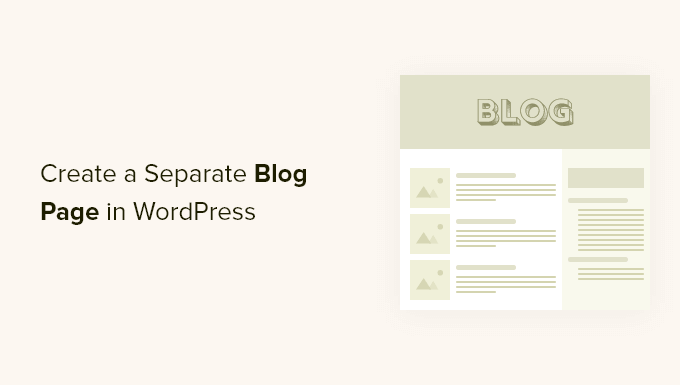
Why Display Blog Posts on a Separate Page?
The home page is the front page of your WordPress website and the first page your visitors see. By default, WordPress shows your most recent posts on your home page, and that makes sense if you are running a blog.
But it’s not always ideal for small business websites. You will probably want a more engaging home page that tells users about your business, products, and services, lets them know how to contact you, and boosts your sales conversion.
Now, if you also want to run a blog on your website, then you will need to provide another page where visitors can go to read your posts.
Having said that, we will show you how to easily create a separate page for blog posts in WordPress.
In this tutorial, we have discussed two methods, and you can use the links below to jump to the method of your choice. Keep in mind that the second method is the simplest and offers the most customization:
Video Tutorial
If you’d prefer written instructions, then just keep reading.
Method 1: Creating Separate Pages for Blog Posts in WordPress
You can create a separate page for blog posts using default WordPress settings.
However, this method takes a little more work than Method 2 and does not offer as many customization options.
Creating a Separate Home Page and Blog Page
First, you must create two separate WordPress pages to use as your home page and blog page.
You don’t need to add any content to those pages, and you can name them anything you like. For instance, some business websites use ‘News’ for their blog page.
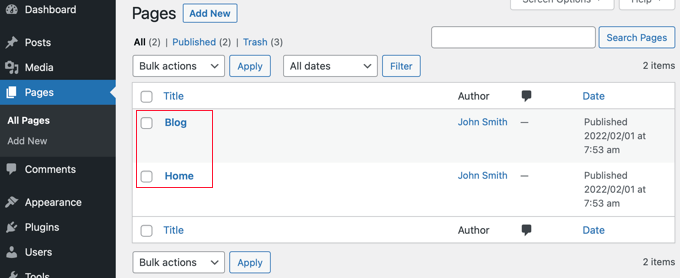
Once you have created those pages, visit the Settings » Reading page in the WordPress admin area.
Now, under the section labeled ‘Your homepage displays’, you need to click on the button for ‘A static page’.
After that, you can select the Home and Blog pages you created earlier. You should then scroll down and click the ‘Save Changes’ button.

Now, when you navigate to the Pages » All Pages screen from the WordPress dashboard, you will see that the Home page is labeled ‘Front Page’ and the Blog page is labeled ‘Posts Page’.
Go ahead and click on the ‘View’ link under the Blog page to preview it.
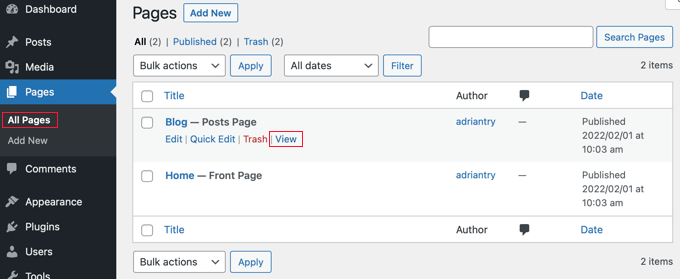
The appearance of these pages depends on your WordPress theme, and you may wish to configure these settings.
For example, if your theme has a navigation menu, then you will notice that WordPress has automatically added the new Blog and Home pages. If not, then refer to our beginner’s guide on how to add a navigation menu in WordPress.
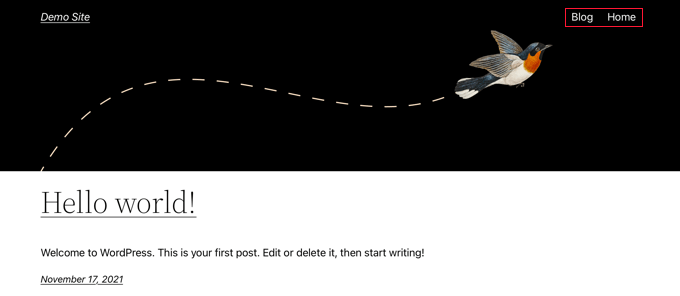
Customizing Your Home Page
So far, your new home page is blank. Now it’s time to add information about your business, products, and services and let your visitors know how they can contact you.
You can learn how to do that in our guide on how to create a custom home page in WordPress. In Method 1, we show you how to use the block editor to add cover images, columns, tables, text and media, galleries, and more.
You’ll also find lots of creative customization ideas in our guide on how to edit a WordPress home page easily and effectively.
Customizing Your Blog Page
If you’re happy with the way your blog page looks, then your job is finished.
However, if you are currently using a block-based theme, then you can also customize your blog page by visiting the Appearance » Editor screen from the WordPress dashboard.
Once you are there, select the ‘Pages’ option from the left column in the full site editor.
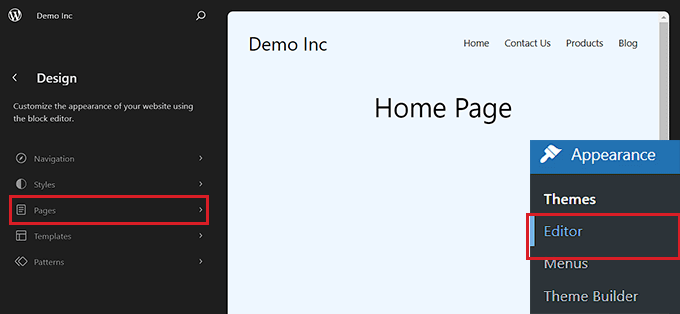
This will open a list of all the pages on your website in the left column.
From here, select the ‘Blog’ page option and then click on the page preview on the right to start customizing your blog page.
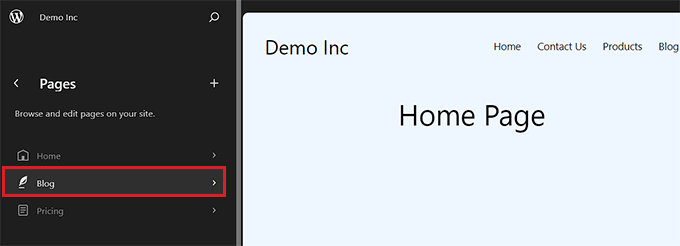
You can now click on the add block ‘+’ button in the top left corner of the screen and add blocks of your choice to the page.
Additionally, you can change the background, text, or link color on your blog page by clicking on the ‘Styles’ icon at the top right corner of the screen.
This will open a block panel on the right from where you can click the ‘Typography’ tab to change text color, the ‘Colors’ tab to change background color, and the ‘Layout’ tab to configure your blog page’s dimensions.
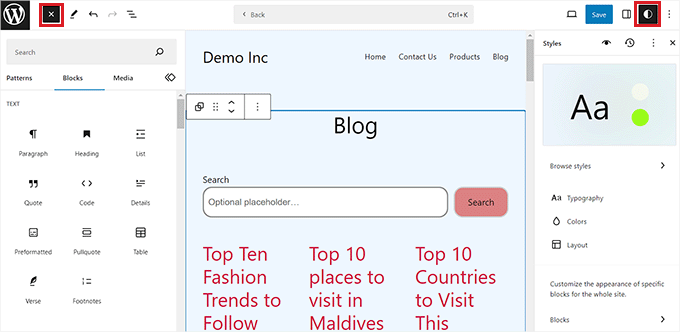
Once you are done, don’t forget to click the ‘Save’ button at the top to store your settings.
Now, you can visit your WordPress blog page to see how it looks.
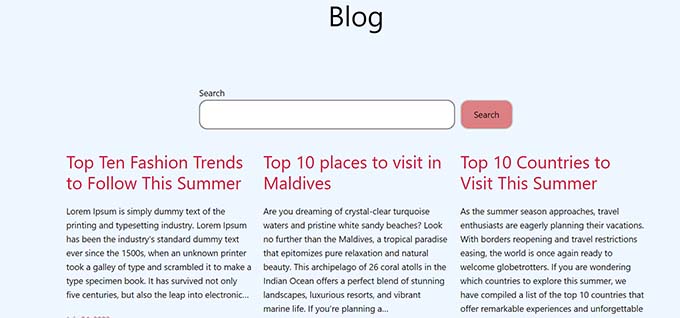
However, if you are using a classic theme, then you will need to use Method 2 instead to customize your blog post page.
Method 2: Creating a Customized Page for Blog Posts With a Drag & Drop Builder (Recommended)
A theme builder plugin allows you to easily create a custom WordPress theme without any code. That includes the ability to create and customize a separate page for blog posts.
Installing the SeedProd Theme Builder
First, you need to install and activate the SeedProd plugin. For more details, see our step-by-step guide on how to install a WordPress plugin.
SeedProd is the best drag-and-drop WordPress page builder for businesses, bloggers, and website owners. It also has a theme designer that allows you to easily customize your blog page and much more.
You can read our complete SeedProd review for more details.
Upon activation, visit the SeedProd » Settings page to enter your license key. You can find this information in your account on the SeedProd website.

After that, it’s time to create a custom WordPress theme. This is much simpler than it sounds.
Creating a Custom WordPress Theme
First, you need to visit the SeedProd » Theme Builder page. Here, you’ll use one of SeedProd’s ready-made themes as a starting point. This will replace your existing WordPress theme with a new, custom design.
You can do that by clicking the ‘Themes’ button.
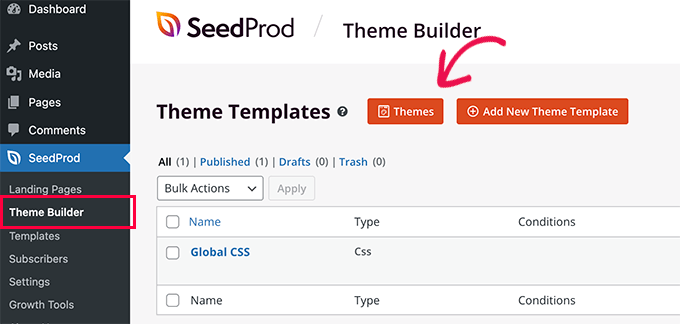
You will now be shown a list of professionally designed themes that are designed for different types of websites.
For example, there are templates called ‘Modern Business’, ‘Marketing Agency’, and ‘Mortgage Broker Theme’.
Have a look through the options and select one that best matches your needs by clicking the checkmark icon.
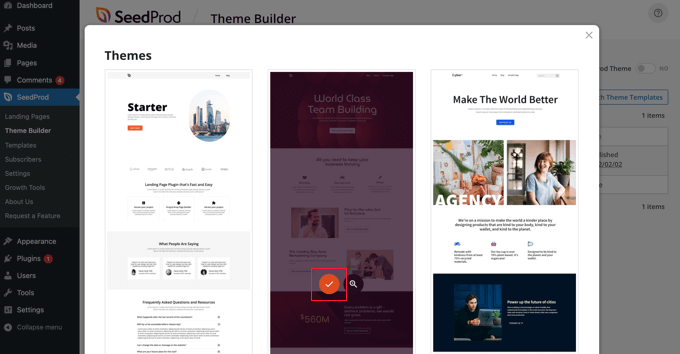
Once you have chosen a theme, SeedProd will generate all the theme templates, including one for your blog index and one for your home page.
These are not just empty pages but come set up with attractive layouts and placeholder content that’s easy to customize.
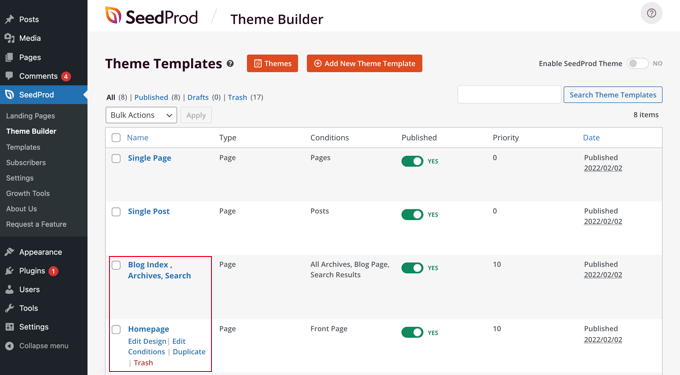
In this tutorial, we will show you how to customize the home page and blog index templates.
You might also like to customize the other templates. To learn how to do that, see our beginner’s guide on how to easily create a custom WordPress theme.
Customizing Your Home Page
Once you have generated your theme templates, you can edit them using the SeedProd theme builder. We will start with the Homepage template.
Simply click the ‘Edit Design’ link under the homepage to get started.

This will launch the template file in the SeedProd theme builder.
This simple drag-and-drop builder will show a live preview of your page to the right and a block toolbar on the left.
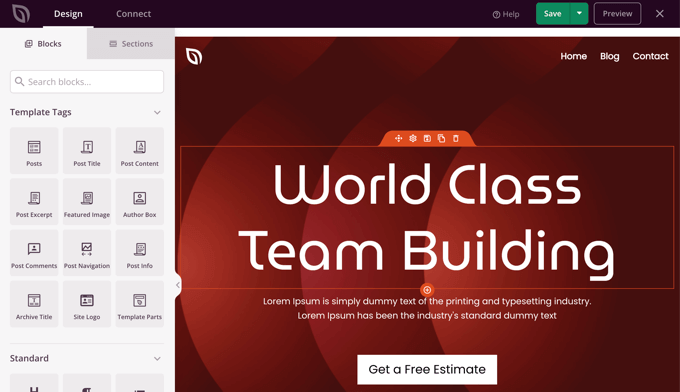
You can customize any block by clicking on it, dragging blocks up and down with your mouse, and adding new blocks to the page.
We’ve written a complete guide on how to create a custom home page in WordPress. Simply scroll down to Method 2 to learn how to customize your home page using SeedProd.
Customizing Your Blog Page
The SeedProd theme builder also provides plenty of ways to customize your blog index page.
Get started by clicking the ‘Edit Design’ link under the page.

You will see the same preview pane on the right and the toolbar on the left. You can customize the blog page the same way you did with the home page.
For example, when you click on the headline, you will be able to see all of its settings. You can edit the text, change the alignment and font size, and more.
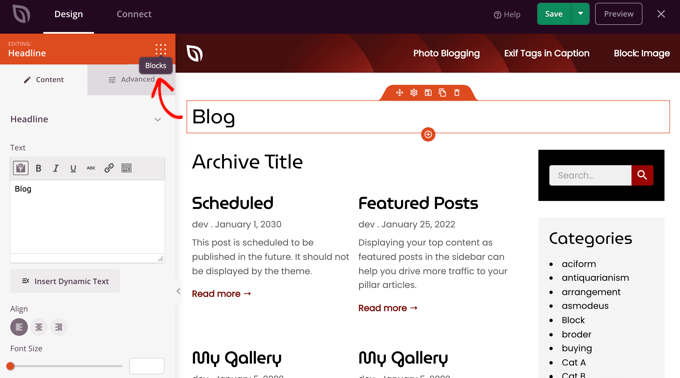
Once you’ve finished, you’ll need to click on the ‘Blocks’ icon to return to the toolbar.
The SeedProd theme builder offers additional Template Parts blocks, such as a Posts block, which displays a list of your blog posts.
The Posts block has already been added to the blog index template for you, and in this template, the block displays your posts in two columns. We can change this to a single column.
Simply click on the Posts block and then change the ‘Columns’ setting to 1.
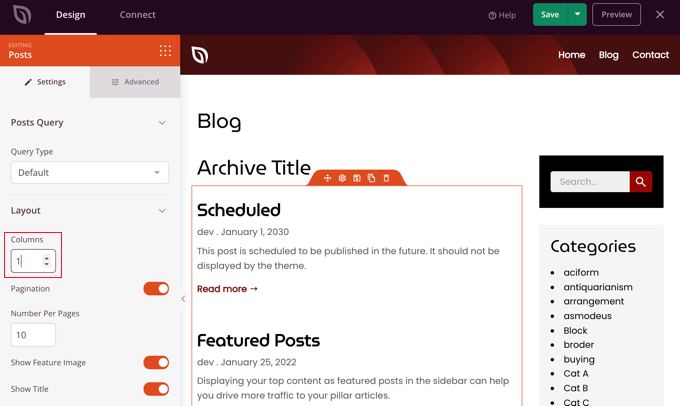
The layout will immediately change to a single column.
As you scroll down the Posts block settings, you’ll find toggle switches that let you choose whether or not to display the post’s feature image and title. You can also choose which header tag to use for the post title.
There are also options for displaying different post metadata. You can toggle the date modified, author, date and time published, and the comment count.
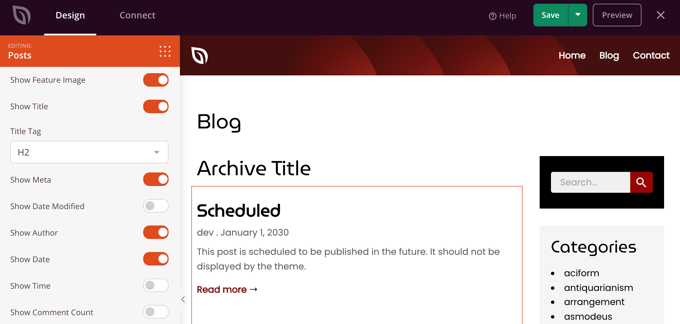
Here are a few more ways that you can customize your blog index:
- You can filter the index by post type, category, tag, or author.
- The sort order of the posts can be changed.
- You can choose how many posts are displayed on a page.
- You can toggle the post excerpt and customize its length.
Once you have finished customizing your blog page, make sure you click the ‘Save’ button at the top of the screen. Then, you can return to the list of templates by clicking the ‘X’ icon.
Enabling the SeedProd Theme
Once you have finished customizing the theme templates, you will need to publish the new custom theme.
Simply toggle the ‘Enable SeedProd Theme’ setting to the ‘YES’ position.
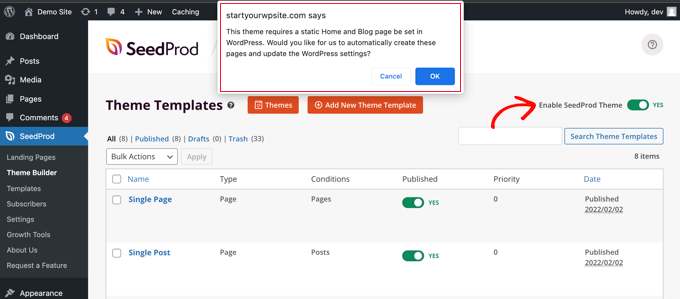
You will immediately see a notification that the WordPress Home and Blog page settings need to be changed. When you click the ‘OK’ button, these settings will be changed for you.
You can now visit your website to view your new home page and blog page. This is how the blog index page looks on our demo site.
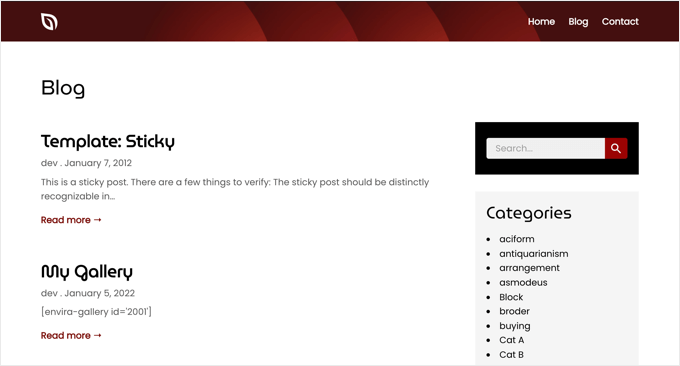
Bonus: Display Your Recent Posts in WordPress
Once you have created a separate blog page, you can still show some recent posts on your home page to encourage users to explore more of your site.
To do this, open your homepage in the WordPress block editor. Once you are there, click the ‘Add Block’ button at the top left corner of the screen to open the block menu.
From here, simply add the ‘Latest Posts’ block to the page. Once you do that, you can customize the list of recent posts to display post excerpts, author names, and dates according to your liking.
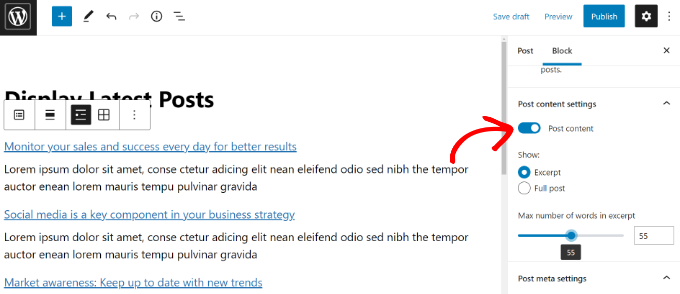
Finally, click the ‘Publish’ button at the top to store your settings. Now, some of your recent posts will still be displayed on the home page to ensure that users spend more time on your website.
For more information, you can see our tutorial on how to display recent posts in WordPress.
We hope this tutorial helped you learn how to create a separate page for blog posts in WordPress. You may also want to learn how to add custom post status for blog posts in WordPress or check out our list of the best related posts plugins for WordPress.
If you liked this article, then please subscribe to our YouTube Channel for WordPress video tutorials. You can also find us on Twitter and Facebook.





Krystian
I can’t figure that one out
I wanted to add some guest posts to my blog, but I want them to be in the separate category (available thru the menu).
For that I created new category, put it up in the menu and I selected the guest post to be visible only in that category (tick box), but when I publish it, it appears in both: my guestpost category (available from the menu) and on my main .com site, where I have all my other posts listed.
How can I turn it off from the main site?
Krystian
Sarah
Hi, just started my blog and am wondering How many posts Wordpress keeps on the same page before having a “see older posts” button at bottom to take you to the next page? My homepage is getting longer and longer by the minute lol. Thanks!
Rhys
Hi Sarah,
You can change the amount of posts you show per page in WordPress Admin > Settings > Readying. The default is 10 from what I understand, although you can change this to whatever you feel like. The more posts per page, the slower load times you may incur.
All the best,
Ruth
Very clearly explained and wonderfully helpful. I had my blog page up and populated within minutes of watching your video. Thank you!
Ronnie
I load the sample page created by wordpress on localhost, it show properly BuT WHEN I access it thru another computer on a different internet, it show not properly.
nishant saraswat
i create my website at wordpress and now i want to create my site user friendly and beautiful i know html and some of javascript,css and php but not completly.i want to create my site beautiful either from some codings or from without codings.so,please help me to create my website.that how i create functions for users to look my site comfort to them please tell me whole process.i create a website by hostgator and sent you my reciept details.please help me i have followed you.
WPBeginner Support
First you need to choose a theme. After that if you want to further customize then you can create a child theme. There are several tools that you can use like CSS Hero and a page builder to quickly create beautiful pages with out writing much code.
Admin
Maya
What if those options are not available under template when creating a new page?
WPBeginner Support
The template names may vary from one theme to another.
Admin
Sally E
Hello,
I’m using the customizr theme and I like how it looks with blog posts showing up on the home page for now.
I would also like to have a “blog” page that links to blog posts as well since later I’ll be writing items that won’t go under the blog tab.
Is there a way to have the blog posts show up on the home page as well as on a separate page?
Thanks in advance!
Rosalinde
I have the same problem, I would love to know how to use the default homepage of the theme and a blog page that links to blog posts.
chibueze
Please, why is it that when I post in my blog, it displays all the contents of my post on that page, including images and Writings
WPBeginner Support
By default WordPress shows full post on all pages. This can be changed by using excerpts. Please see our guide How to customize WordPress excerpts no coding required.
Admin
Michelle
Like many others, I’ve been trying everything to figure this out…thank you for making it so easy!!!
Kristy
After a long, frustrating day of trying to figure this out, I will sleep a little better tonight. It now seems so obvious but for some reason, I just couldn’t figure it out today. I googled and read several forum posts where everyone said this was impossible & you just had to create category to handle a blog. I really didn’t like the way this looked on my site but decided I would just have to deal with it until I figured something else out. Thanks so much for this video. You have made my day! Now I’m going to check out your other articles hoping they will be helpful with my hundreds of other questions.
Tuncay
Hi,
I have a news website, I want to create a Forum Page, but the forum page should be take the news from other pages and my visitors can disscuss under the news in forum page,
how cna it be possilbe?
could you please help me on this?
Thanks
WPBeginner Support
See our guide on how to add bbPress forum for WordPress posts comments. This approach allows you to add a forum thread for each article you publish.
Admin
Harshit
Hi ,
This is a very helpful video. It really helpful to me. thank you for the tutorial. And you have a very nice voice.
thank you,
Zach
Helpful, thanks.
But it looks like my theme only has one template (“Default Template).
When I go to Pages, and try to Quick Edit my page, I only see “Default Template” in the dropdown of “Templates.”
Am I able to add/import more templates into my current theme? I couldn’t find a WPBeginner tutorial on this…
Thanks,
Zach
WPBeginner Support
Seems like your theme does not have a separate template for blog posts. You can try using the default template and see if it does what you need. Alternately, you can create a custom template of your own. See our tutorial How to create a custom page in WordPress. Please note that it requires some basic knowledge of html and php.
Admin
Zeeshan Ali Kaimkhani
good project
Gary
Grerat video, Thanks But when I changed the posts to the blog page, my custom theme home page is also showing the blogs. How do I keep the current custom theme home page and just move the blogs to the new blog page?
Thank you in advance.
Gary
WPBeginner Support
Please contact your theme support.
Admin
Mohsin
Hi thanks for your tutorial.
but i have problem
i am creating custom theme and i have multiple option on page for example page layout and enable top slider on this page but when i select posts page : blog
custom options are not working.
Elizabeth
Wonderful! Been searching for a very simple and straight forward tutorial, glad I found this site!
Lara
Your tutorial was awesome, thank you so much! So simple and straightforward, you helped me get my blog up and running in a few minutes. You rock!
Debbie
My problem is that on the blog page, where just the excerpts are, it reads about the first 55 words of my blog posts, but then there is no “More” or anything for them to click to read the entire post. How do I create that? They can click the image of the post, and it takes them to the full post, but there is no information that says to do that. I’m stumped!
Stephanie
OMG this was SO helpful. As a novice blogger I was finding it so impossible to create a blog post page and include that page on my menu. I can’t tell you how many times I attempted to do this in the most complicated ways. Thank you for the EASY and FAST tutorial! I am so happy!
Diane Lee
Thank you for this tutorial. I’m new to Wordpress, and this was very helpful!
Ted Sherwood
Syed and team. First, thanks for a very helpful site. It’s now the first place I go to for Wordpress help.
I have a theme that allows my latest posts or a static page for the front page. I already have many blog posts. And I have an existing page that I could use, with a couple of additions probably, as my front page. So I interpreted the above article as implying that I don’t need to create any new pages. However, when I try and follow your Settings/Reading instructions, there is no option under Posts for the blog page, just all the other existing pages. Perhaps there’s something I’ve missed?
WPBeginner Support
The article does mention that you need to create a new page for your blog posts.
Admin
Jason G
Very helpful especially if you have not been using a blog and are only accustomed to static pages on your sites. Thanks!
Arfa
Hey syed
Though the article is really helpful and I am succeeded in adding pages to my blog but can you please tell me how to add a post in that particular page like i have added page titled as food for thought and i have to add a post in that, how can i do that ?
Please advice.
Patti
I’m having the same issue….
Harold Buchman
Excellent tutorial –
One thing to look out for:
My custom blog page did not work while I was signed in as the administrator on my WP control panel in another browser window. As soon as I signed out, the link worked exactly as describe.
Charli
I don’t have the reading settings option… do you know what i should do ?
Abel
Good enough i hadn’t yet published my website to the world This is so helpful.. I would have forget-en how to do this and ended up ridiculously frustrated.
Heather
Thanks for the help—but I have another question kind of related..
Every post i create in my wordpress is appearing in my BLOG section..even though I do not have the ‘blog’ category (or any for that matter checked before publishing.
Here’s my site – –can you help
elizabeth
What if I want to create 2 pages but those 2 pages should have my blog posts. for eg: one page should blogs about clothing and another page should have blogs about “jewellery”
Judi Sutherland
My understanding is that you can’t have two pages of blog – only one on any site. Unless anyone knows different.
Steve
You can have as many blog pages as you like if you create custom page templates with the Wordpress loop in each. This is more a nudge in the right direction than a complete answer. Hope it helps some
Riaz
Been searching hours for this, thank you Syed!
Christina Elizabeth
Thank you for this tutorial. It has been very useful. I now have a menu of separate categories for my blog. I will be back I am sure!
rovingjay
Worked like a charm … thanks for the really helpful video. I’ve been wanted to switch to a static home page but didn’t know how to also have a blog post page – one simple search and I found wpbeginner! Really appreciate it. thanks, Jay
aprav kumar
Thanks but After i did this Widgets missing from Blog Page
I am using Minamaze theme
and using plugin “eCommerce Product Catalog” by impleCode for product catalog ,since i dont want sidebar widgets to appear in all pages I used plugin “Widget logic” to make widgets appear just 2 pages which are “Blog” post page and “Products” Page .
And then all the posts are appearing in “Home” Page which is front page , so i changed “Static Front Page” Option from “Latest posts” to “Static Page” and FrontPage to Home and Posts Page to Blog , The moment i saved …. Widgets in “Blog” Page dissappeard but in “products” page it is showing up …..
Please Help me with this…. I am newbie in WordPress( just 2 days)
Jenny
this is happening to me, too, did you get an answer?
WPBeginner Staff
Many WordPress themes use a full width page template for pages with no sidebars. You can see if there are multiple templates available by editing the page in WordPress. When you will edit the page on your right hand you will see a meta box labeled templates with a dropdown menu. Try switching templates to see if you have one with the sidebar.
Jonella
I have a Blog page already. The blog posts appeared when I made a page edit and then they didn’t. I tried to revert back to the previously saved version but the posts aren’t there anymore. I can find the posts in the Posts section, they’re just not “connecting” to the Blog page anymore if that makes sense. I’m slightly panicking. Can someone help me out?
Ojabierto
Thanks a lot, you saved my night!
WPBeginner Staff
Jill this means your blog page is not working correctly, please follow the instructions carefully again.
Jill
This worked great for me but my blog page doesn’t have my blogs on – they are showing on the home page in a list in sidebar with “Archive”
Aniee
Nice , Could you explain a bit will the Seo work? in same way ? please elaborate. wile creating a seperate blog page , will seo of the website as a whole be effected, i mean with ‘/blog’ is better or just http://www.website.com , or both are same ? (in regards to seo)
Henrique
This was really useful and fast to read/implement, thanks!
WPBeginner Staff
Twenty Thirteen supports templates.
sumeet kumar
i can not understand the blog and cms in websites. please help…..
David
Looks like Twenty Thirteen, the theme I am using, doesn’t support this template feature which Twenty Twelve has. Right? What’s the solution in this case then? Any ideas?
Francois
How do I get the posts on my homepage I made a blog to display the posts as a list?
WPBeginner Staff
Did you try disabling comments on the home page by editing it?
Your blog page is just a placeholder. You are not supposed to edit it. The display of your blog entries on that page is handled by your theme.
Go to pages and edit the blog page. Under Page Attributes meta box, select default template and save your changes.
Hope this helps.
Claudius_II
Am attempting to create a blog on a blog page and have a fixed front page for my website. Have followed all your instructions as above and still comments [or blogs?] appear on the front page.
The blogs page has no fields for inserting comments or blog entries. I’ve disabled comments for this page so only blog comments should appear here.
Under Reading Settings have done exactly what you illustrate, a static front page and blogs to a blogs page. Have a menu item on my front page aslo which goes to blogs page. Blogs page exists but is unwritable.
What am I doing wrong?
Using the commercial “X” theme.
site is here:
Note some page links not working for all pages.
Thanks very much for any help.
firdaus
thanks. it works just nice
Anne
I’ve spent hundreds of dollars on books and courses to try to learn Wordpress. Your tutorials are the first thing that finally enabled me to do what I need to do with my website. Thank you!
SmartglassesHQ
This is so helpful.. I always forget how to do this and end up ridiculously frustrated. I’ll try to remember for next time.
Yousuf Atik
Is there a way to post blog entries in different pages of the site? I would like to divide my blog into 3 section and post different blog entries in the different pages
WPBeginner Staff
Yes, there are several ways to do this. You can create categories for each section and use the categories in your site’s navigation menu. Then you can use a static page as your site’s front page.